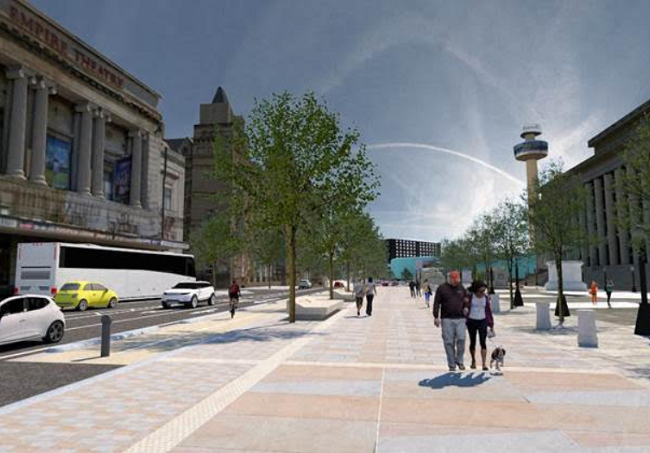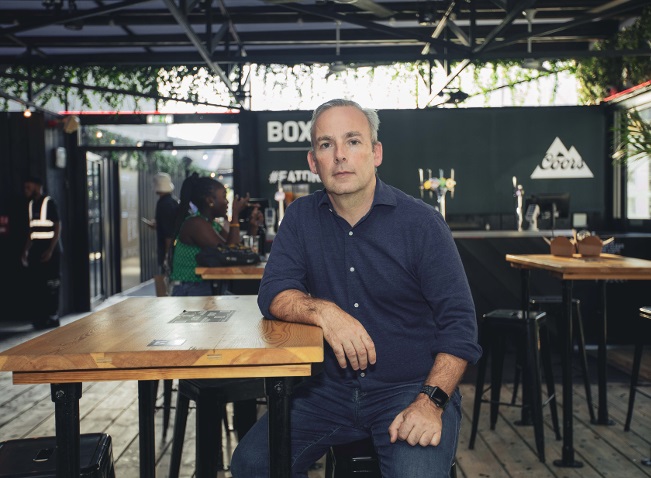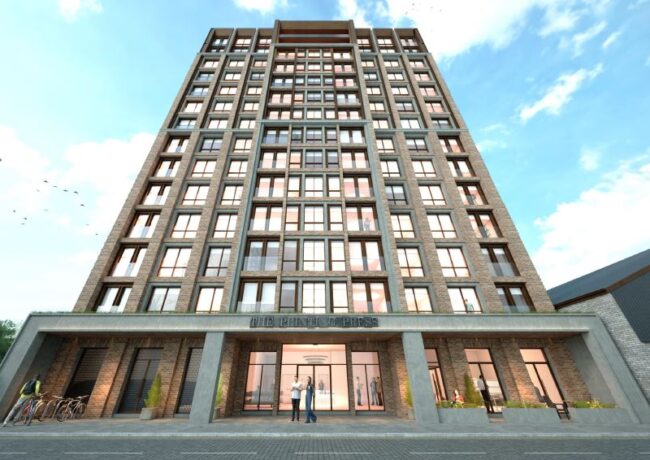Liverpool reveals Lime Street plans
The city council has announced details of Lime Street’s redevelopment, which forms part of the next phase of the £47m Liverpool City Centre Connectivity programme, which aims to reduce congestion and improve air quality.
The Lime Street element of the project had been subject to the demolition of the 50-year old Churchill Way flyovers, which is ongoing, and the council securing approval for a bus hub, which it has received.
The scheme is receiving £40.1m from the Local Growth Fund, with match funding of £7m. This is one of the major elements of the city council’s £500m Better Roads Programme. LGF money is awarded to the Liverpool City Region Local Enterprise Partnership and invested through the Liverpool City Region Combined Authority through its Strategic Investment Fund.
Following public feedback and a re-appraisal, the council is reintroducing a segregated cycle lane on Lime Street. This will be next to a public square outside the train station and an expanded plateau outside the grade one-listed St George’s Hall.
The Lime Street designs also include the installation of a water feature at the southern end of the plateau. A widened pavement which will run the entire length up to the Adelphi Hotel will also come as part of the revamp.
Construction is set to begin in May 2020 to reduce Lime Street into a single carriageway in both directions, with the southbound lane giving access to St Johns Shopping Centre car park.
South of Lime Street station will be single lane only, with northbound traffic and buses no longer able to travel past the ABC Cinema and Holiday Inn hotel. Subsequently, due to the timings of these works, which were originally envisaged for January, a revised date for route changes will be posted, the council said.
Further traffic modelling and surveys have revealed that the 82 bus service from South Liverpool will be able to continue to use Hanover Street, but will be subject to the introduction of bus priority measures such as a bus gate or a bus lane, which is currently being mapped out.
The bus hub on Old Haymarket will come into partial use in January, before becoming fully operational later in 2020.
The Queen Square bus station will become the focus for northbound bus routes, and the Liverpool One bus station will be for southbound bus routes. These will be underpinned by the Lime Street redesign.
By rerouting these services and building the bus hub, the council estimates it will save over 900,000 km of bus travel and 2,000 tonnes of CO2.
Other phase 1 schemes include:
- Moorfields: Improving the footways to enhance the area and the entrance into Moorfields station. Completed in summer 2019
- Victoria Street: This will include removal of bus layovers as well as tree planting and public realm features, creating wider footways and options for street cafés. Set to complete in March 2020
- Brownlow Hill: Creating a cycle link with Lime Street, and improved public areas that create access to the Knowledge Quarter. Set to complete in March 2020
- Tithebarn Street: Includes the creation of cycleways to enhance links with Lime Street and the waterfront. Set to complete in June 2020.
- City Coach Park: Parking provision for 30 vehicles on Riverside Drive. Set to complete in April 2020.
The second phase will see a series of highways improvements along The Strand, with work scheduled to begin in Spring 2020. A series of public consultation events will be held in the new year.
Cllr Sharon Connor, cabinet member for highways at Liverpool City Council, said: “Lime Street is the gateway into Liverpool for millions of people, and we aim to provide them with a world-class welcome.
“A new public square outside Lime Street station and an expanded plateau at St George’s Hall will transform the experience of arriving in Liverpool and how people interact with arguably the UK’s greatest collection of iconic cultural venues.”
Minor changes to original plans were made, in particular the development of the cycle lane, which was paused while the council assessed the impact of the removal of the Churchill Way Flyover, Connor added.
The city also declared a climate change emergency in July 2019, and the new bus hub and forthcoming timetable changes from April are intended to reduce road congestion and improve the council’s carbon footprint and air quality.





Looks good. Hope they do actually plant the trees. All too often they use them to enhance their plans and then don’t actually plant any. Evergreen spruces maybe?
By Anonymous
All great ideas to reduce car traffic within the city, but let’s hope the existing public transport can keep up with demand. No point reducing the number of lanes and accessibility within the city if vehicular transport is the only way people can get around.
By Mark
This will be interesting when it starts, will all the North bound traffic have to go through Charlotte Street or are they being diverted up Copperas Hill?
By Man on bicycle
Looks nice, but will the greening aspect be a token gesture, or serious? Too many schemes are announced with wonderful CGIs of trees, greenery and foliage, but when push comes to shove, the soft landscaping is often dropped. The Victoria Street uplift is a classic case, all trees have been removed from the designs. Other cities use attractive planters in paved areas where sub-terrain is an issue… why can’t we do the same in Liverpool to further enhance the urban space? Visitors to the city, particularly from overseas, expect it.
By Dezine
You’re right, @Dezine, overseas visitors do expect trees! I hope these are thought through correctly, well spaced – formally! as this is a formal space – and account taken of the slope in the land. Trees were planted more than 20 years ago on Lime Street but they only remain at the north end of St. George’s Hall. The rest died off within a year or so as the southern end of The Plateau is raised land and therefore as dry as a bone! I hope you are using the best landscape architects LCC!
By Liverpolitan
Very impressive …but has any provision been made to allow for the possibility of a new tram system ?…Most major cities are transport oriented to include them…..
By Tercol
How will I get from South Liverpool to Lime Street Station by either car or public transport?
By Forward Thinker
Is Lime Street, always that quiet, I think not, no buses shown and only three cars and not even a single taxi? This looks ill thought!
By Nice view, but big Queue
If overseas visitors want to see trees, then they should bring their own, I am fed up with them moaning about the lack of trees.
By Plant more
Another positive step.
By Anonymous
I think it’s a great idea to keep traffic to a minimum.
Get people walking around our great city and see what we have.
It’s great to see their introducing segregated cycle lane.
By Tommy Hengler
What about a Mono rail to Liverpool Airport from Liverpool South Parkway hub?
Why is it that a major city like Liverpool cannot get enough funding for a Tram network to reduce pollution and enable people to get around the area easier?
A lot of tax payers money appears to be put into schemes to reduce the number of road lanes…will this increase the amount of congestion?
By Rob
@tercol – the existing road junction Lime St and St Johns Lane had to be designed in the mid-2000s for exactly that reason – thereby restricting the amount and design of the public space, and creating a less-than-optimal pedestrian experience. Regardless of the fact that everyone knew by then there was absolutely no chance of “MerseyTram” ever being built, despite the amount of £ thrown (controversially) at it by the ex-CEX of Merseytravel… There’s reason why he emigrated to Oz 😉
By MancLad
Looks very nice, our city would benefit the wildlife , the birds as we should have more trees in the city centre to attract nature at its best. Some nice sitting areas , water features and maybe a litt pond with aquatic plants 4 the wild life , let’s do the city proud so everyone who comes here 2 visit from far or near will appreciate the wonderful city it is ,
By Stephen Curran
It looks like we only want tourist in town because local people are getting feed up with the roadworks and will stop going to the city centre witch will not help the shops
By Tt
Sort out the city centre for Wirral buses. Sir Thomas street doesn’t have the capacity for the amount of buses using it. It’s constantly on the verge of being a massive accident.
By Anon
Are the lions being removed in this proposal?
By Carl Dean
Too right. Not enough trees/greenspace in Liverpool. What happened to Bixteth Street Gardens? So many broken promises.
‘Liverpool Year of Environment. 2019 will be a year of green action across Liverpool City Region where people from all backgrounds will have the opportunity to be involved in projects that improve the natural world’
By Treesaregood
There is an underground rail station at Lime Street with connections to 4 city centre metro stations and 3 in Birkenhead as well as out into the suburbs. The transport is pretty good by any standards.
By Red Squirrel
Liverpool will have one of the country’s greatest public spaces when this is complete.
By Red Squirrel
STOP the car parking on the Plateau. It ruins the image of St George’s Hall and surrounding buildings.
By Anonymous
I quite like what is happening here and think it should improve things. This is a wonderful entrance to Liverpool, although sadly the only eyesore once you leave Lime Street Station will remain – St Johns. Gosh that ruins such a wonderful entrance.
@Red Squirrel, I don’t think Liverpool’s transport is that good. For a start, there are not 4 innercity stations directly connected, only 2 and it is not full metro standards. I just checked and if I were to get a train between Lime Street & Moorfields, that would take between 11 and 25 minutes and this is on a weekday. 25 minutes doesn’t include the time to get down to Lime St Lower Level or up from Moorfields. If it were a proper metro, it would have a dual track and I could travel in both directions. This would reduce the time from 25 minutes to 2 minutes – a huge saving. Melbourne in Australia had a similar problem with their innercity loop, but at least you could do a full loop (to save time) and even then they have long since upgraded it to both directions
By EOD
Not sure this is the answer. They made a mess of Dale Street when reducing the lanes; they had to scupper the plans for The Strand; and Lime Street is difficult now; fewer lanes does not mean less traffic, it means more gridlock.
By Anonymous
Given the widespread doubts about and criticism of this programme of work from multiple angles and people, re whether worth doing, through to impact on transport, and given the “recent developments” at the council, should the entire programme of works and any such spend not be immediately halted, pending external review and audit?
I can think of many transformative regeneration projects in liverpool to spend £45m on, which the public would actually notice, want, benefit from, and which would turn a profit for the city. None of those involve spending millions on paving flags.
By Mike